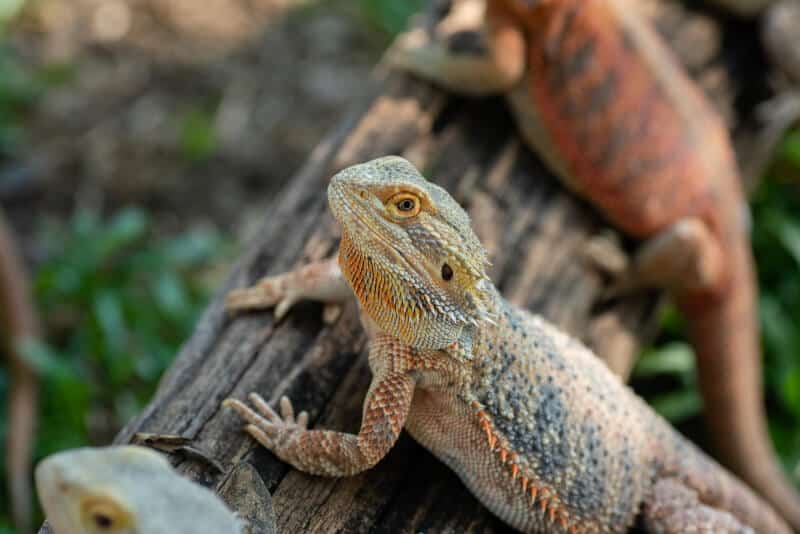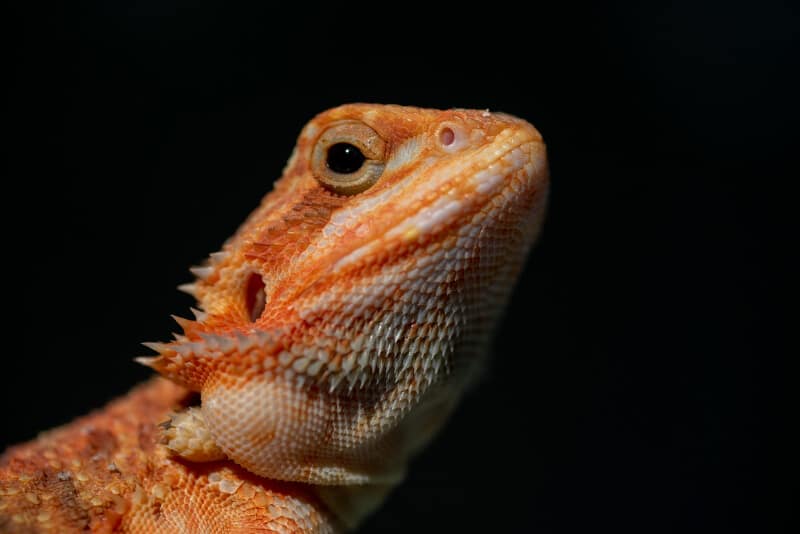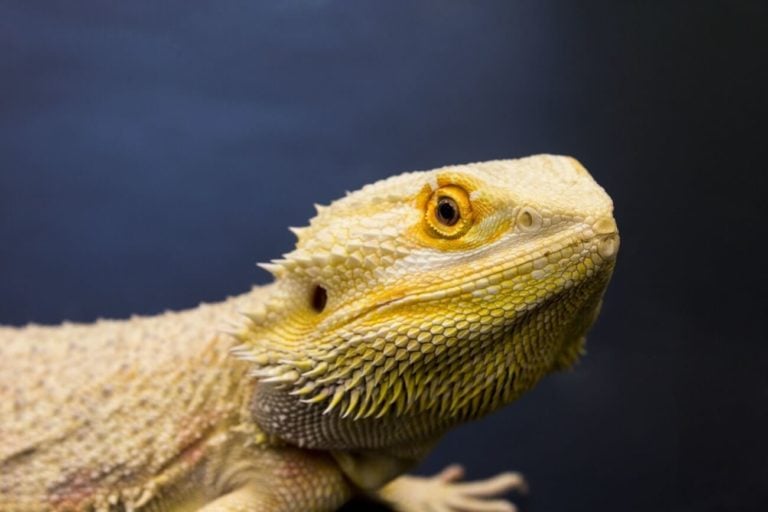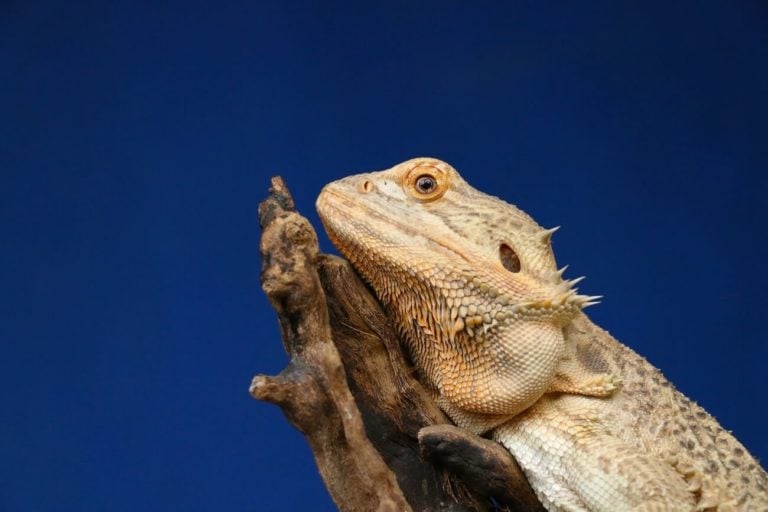It can be challenging to figure out the cause when bearded dragons throw up. Is it just an innocuous “animal moment” or something more serious?
This guide will help you figure out what’s going on, so you can take action if needed.
Table of Contents
Why Bearded Dragons Throw Up
Seeing your bearded dragon throw up is never a good sign. While a single vomiting session isn’t too much cause for concern, regurgitation could point to potential health issues or issues with their care.
Here are some of the most common reasons why bearded dragons throw up.
1. Dehydration
These reptiles come from arid regions of Australia, so they’re used to getting by without tons of water. But like any other living thing, bearded dragons have their limits. Dehydration is a common cause of vomiting, and it could lead to more severe problems moving forward.
Expert Tip: One way you can test hydration is by pinching the skin. Hydrated bearded dragons will have skin that easily bounces back. But if your reptile’s pinches skin stays put or moves back very slowly, you could have a hydration problem on your hands.
Water is essential to survival, but bearded dragons are notorious for avoiding it. They prefer to get their hydration through foods, and it’s rare to see them lap up a drink from a bowl. Even still, it’s important to give them plenty of ways to hydrate.
Place a fresh bowl of water in the enclosure, install a dropper, or use a hand dropper to get your lizard to drink directly. Many beardie owners like to offer Pedialyte if dehydration is evident. The nutrient-rich drink is full of electrolytes and does a fantastic job of helping a dehydrated lizard back on its feet.
You can also mist the enclosure daily and bathe your beardie or feed it high-moisture foods.
2. Eating Something That’s Bad For Them
Bearded dragons have pretty tough systems, but they can also succumb to the effects of eating something less-than-ideal for their dietary needs. These animals are naturally curious and love to snack on anything they can find in their enclosures. That includes potentially dangerous foods and plants.
If you have live plants in the habitat, make sure they’re safe for beardies!

Some plants that are known to harm bearded dragons include daffodils, peonies, lilies, poppy, wisteria, and more. These plants contain toxic compounds that don’t agree with your lizard’s system. Even a small nibble can cause the body to reject the food, resulting in regurgitation.
But that’s not all.
Even foods that are relatively safe for bearded dragons can cause trouble. Take, for example, mealworms, or superworms. These foods are often included in many beardie diets.
However, they can have particularly tough exoskeletons that bearded dragons can’t fully digest. That means eating too many could lead to severe health problems (more on that later).
Too many of these tougher exoskeletons can cause bearded dragons to vomit in the short term. The best thing you can do is reassess your beardie’s diet, remove any potentially dangerous plants, and focus on feeding safe foods to meet their dietary needs.
3. Impaction
Impaction is a medical issue that you should not take lightly.
This condition refers to blockages in the digestive tract. It’s akin to constipation in humans. Things get blocked up, making it difficult for your bearded dragon to produce waste.
Unfortunately, this issue is more common than many owners realize, and it can occur for many different reasons.
One cause of impaction is the size and toughness of the bugs they eat. Insects with tough exoskeletons (such as mealworms or superworms) can cause problems. A few bugs are fine but take longer to process than other insects. So when a beardie eats several insects with hard exoskeletons at one time, they might need to throw up!
The same goes for large bugs. Insects wider than the distance between your lizard’s eyes are tougher to swallow and digest.
The substrate can cause trouble, too. When live insects attempt to flee your bearded dragon, they often run onto the substrate. The bug gets covered in fine bits of sand that the lizard ends up swallowing.
These lizards aren’t built to digest sand or soil, so it gets stuck in their system.
Expert Tip: Impaction can be painful and potentially lethal. Consider giving your bearded dragon a warm bath. Gentle massages can encourage the impaction to pass, but you’ll need to visit a vet if no improvements occur.
4. Parasites
Another cause of bearded dragons vomiting could be parasitic infections. Parasites can invade your pet’s body, feeding off of them and causing various health problems. Some of those parasites already exist in your lizard’s system.
One of the most common parasites you’ll deal with when owning a bearded dragon is Coccidia.
Coccidia is a single-cell organism that lives within your lizard’s digestive tract.
Coccidia is most known among pet owners as affecting cats and dogs, but it can harm bearded dragons, too. Typically, the parasite doesn’t cause any problems. The beardie’s immune system knows how to handle it and prevent infections from getting out of control.
But when a bearded dragon has a weakened immune system and lives in a poorly maintained enclosure, Coccidia numbers will flourish and cause issues. The same goes for other parasitic microorganisms.
Parasites can cause many unwanted symptoms. In addition to your bearded dragon throwing up, it can make them lethargic, cause bouts of diarrhea, lead to weight loss, and more.
Take your bearded dragon to a vet if you suspect parasites are to blame for vomiting. Fortunately, many treatment options are available to bring your lizard back to good health.
5. GI Issues
Bearded dragons experience digestive troubles just like any other animal. Their gut contains a delicate microbiome of healthy bacteria that helps to process foods efficiently. When issues arise to throw off the balance of the lizard’s gastrointestinal tract, they might need to throw up.
There are many reasons why GI issues happen. It could be that your beardie ate something difficult to process, or they may have developed Salmonellosis from the overgrowth of bacteria. Whatever the case, vomiting is a common reaction.
Restoring your bearded dragon’s GI health can take time and careful adjustment of their diet. It’s also important to maintain enclosure conditions and clean the habitat regularly to avoid illness-causing bacteria.
Consult your vet for treatment and take steps to avoid issues in the future.
6. Overfeeding
You know this feeling far too well if you’ve ever overindulged at an all-you-can-eat buffet. Bearded dragons can get sick if they eat too much food just like us! Unfortunately, many owners don’t know the stopping point.
Bearded dragons can be challenging when it comes to feeding. Sometimes they have insatiable appetites. Other times, they don’t seem to want to eat at all. Their appetites come and go, so it’s common for owners to feed as much food as their lizards want when their appetites are high.
But here’s the thing about bearded dragons. They don’t know when to stop eating when they’re hungry. Overstuffing can cause impaction issues as the body struggles to process what it already has. That forces the lizard to regurgitate some of its food.
This issue is more common when the lizard indulges in insects. As mentioned earlier, mealworms and other bugs with hard exoskeletons take time to digest fully.
The best thing for your bearded dragon is feeding limitations!
Typically, younger lizards up to four months old will need two or three small meals a day. Once they reach the juvenile phase, it’s best to cut back to only two meals daily. After reaching maturity at 18 months, bearded dragons should only eat once per day.
During that single feeding, a beardie should only eat what it can for about 10 to 15 minutes. After that, remove the excess food to ensure your bearded dragon doesn’t overindulge and end up vomiting.
7. Salmonella
Salmonella is a type of bacteria that always raises red flags when people hear it. You know to avoid it in your food, but did you know that bearded dragons can carry it?
These lizards can contract Salmonella bacteria through interaction with an infected reptile, improper handling, and general unhygienic living conditions. Like Coccidia, Salmonella can live in a bearded dragon’s digestive system without causing any trouble.
But the moment the bacteria has a chance to flourish, it takes advantage and wreaks havoc on your lizard’s system. When the immune system is weakened and cannot suppress the bacteria, it proliferates to the point of causing Salmonellosis.
Salmonellosis is a gastrointestinal disease that can cause vomiting, diarrhea, cramps, fever, and more. It can eventually kill them.
Expert Tip: It’s also possible for your bearded dragon to spread Salmonella bacteria to you and your family. It’s essential to exercise caution and seek treatment for your lizard as soon as possible.
8. High Humidity
Your bearded dragon’s enclosure impacts its health more than you may realize. These lizards can’t function when conditions aren’t right. One of the most critical environmental factors to keep an eye on is humidity.

Reptiles need humidity to stay healthy, but it’s not about pumping the habitat with moisture. Bearded dragons come from arid regions. They won’t survive long in an ultra-humid environment that mimics tropical jungles!
Ideally, humidity levels for a bearded dragon should be around 30 to 40 percent. Any higher or lower than that, and health problems will come.
Improper humidity levels can lead to a wide range of health complications. That includes digestive troubles, respiratory infections, and more. And as you know, any number of these could lead to your bearded dragon throwing up.
Invest in a high-quality digital hygrometer. Place it in the enclosure and monitor conditions at all times.
When humidity gets too high, open up ventilation holes to let the space breathe. If they’re too low, mist the tank and create a comfortable environment.
9. Incorrect Enclosure Temperature
Like humidity, incorrect temperature settings can cause your bearded dragon to get sick and throw up.
These pet lizards require comfortable temperatures and ample UVB lighting to process foods. It’s essential to many biological functions.
Without the right amount of heat, digestive processes slow down. The food your lizard eats essentially stays in the stomach until it goes sour, triggering the regurgitation.
A solid lighting system is paramount for bearded dragons. These cold-blooded animals thermoregulate by moving to different parts of the environment. As a result, you can’t have a static temperature throughout. You need a temperature gradient.
On one side of the enclosure, install a basking lamp with temperatures up to 110 degrees Fahrenheit. On the other end, keep things to a cool 80 degrees.
Many experienced owners have two thermometers to monitor both sides of the tank separately. We suggest you do the same to ensure that things are stable around the clock.
Don’t forget about lighting. A standard day/night cycle with 14 hours of light is critical to the lizard’s health. The same goes for UVB light. The UVB rays help with digestion and calcium synthesis.
Take time to establish a rock-solid temperature and lighting setup. Keep an eye on temperatures and make adjustments when necessary.
Why Your Bearded Dragon Is Throwing Up With No Appetite
No interest in food should always raise a red flag. When it pairs with throwing up, you should be concerned. Not eating can exacerbate existing health problems, causing your bearded dragon to lose weight and slow down recovery.
So why is this happening?
In many cases, impaction is to blame. When the digestive system can’t process foods, and your beardie can’t pass any waste, they have no more room to eat. They’ll begin to consume less food to avoid worsening the problem and causing more pain.
Another reason your bearded dragon is throwing up and not eating is that they’re recovering from an illness. Gastrointestinal upsets and infections can take a toll on their body, causing them to avoid food altogether until they have the strength to eat again.
To address this issue, see if your bearded dragon is impacted. Monitor them closely and make a note of any stool they pass. In the meantime, check on temperature and lighting settings to ensure they have the support they need to digest food properly.
If impaction is to blame, give them a warm bath and gentle massage.
If the problem persists, take your bearded dragon to the vet immediately. Try to gather up some vomit for testing, and your vet will be able to diagnose the problem and recommend treatment.
Why Your Bearded Dragon Is Throwing Up Water
It’s actually relatively common for bearded dragons to throw up water. They don’t always swallow water that they lap up. Instead, they hold it in their mouths, causing them to throw it up whenever they open their jaws.
Many bearded dragons throw up water when they drink on a ledge or while climbing. They need their bodies to be relatively horizontal to swallow everything.
There’s typically no cause for concern in those instances. But if your bearded dragon throws up water repeatedly, it could be that its water source is dirty. Clean the dish or dropper, refill it with clean water, and allow your lizard to rehydrate.
Why Your Bearded Dragon Is Throwing Up Mucus
Bearded dragons can throw up thick, gelatinous mucus. It may be transparent or have a slight tinge of yellow.
There are a few reasons why they might throw up mucus.
The first is that they’re dealing with an upper respiratory infection. These infections occur when there’s too much moisture in the air. Bacteria overgrows, causing the tissue lining the mouth and throat to inflame.
Respiratory infections are not something to take lightly. Check on humidity levels. There’s a good chance that the humidity is too high.
Take your bearded dragon to a vet for antibiotic treatments, and this problem can be resolved.
Another reason bearded dragons vomit mucus is filthy drinking water. Bacteria can prosper in water that sits for longer than a few hours. That bacteria can cause infection and illness, resulting in mucus-filled vomit.
You should clean and refill water receptacles at least once a day. If you can do it multiple times a day, even better!
The type of water you provide matters, too. Standard tap water can have high levels of chemicals like fluoride. Mineral content can be too much for the lizard to handle as well.
Switch to filtered or distilled water to ensure that your bearded dragon gets pure, clean water every time they go in for a drink.
Why Your Bearded Dragon Is Throwing Up Blood
Seeing your bearded dragon throw up blood is alarming, and it’s not something you should ignore.
First, make sure that you’re actually viewing vomit. Sometimes, bearded dragon stool can look like bloody vomit. Many owners mistake feces for regurgitation, so you must keep an eye on your lizard and ensure you see which end that bloody mess comes from.
If it is, indeed, vomit, there are a couple of possible culprits.
The first is a bad liver. Fatty liver disease affects overweight bearded dragons that often overeat. Fat develops in the liver, interfering with its biological function.
A fatty liver usually causes reptiles to grow weak and lethargic. Their appetite may suffer as well.
Another cause of bloody vomit is cancer. Cancerous masses can cause bearded dragons to throw up blood, and it’s usually one of many possible symptoms.
Regardless of the reason, bring your bearded dragon to a vet as soon as possible. Bloody regurgitation almost always indicates underlying health problems, and the sooner you get veterinary attention, the better.
When To Take Your Vomiting Bearded Dragon To The Vet
One of the most challenging decisions you’ll have to make when seeing your bearded dragon throw up is when to seek veterinary care.
As a good rule of thumb, you should immediately take your beardie to a vet whenever they vomit blood or mucus. Those two instances could point to severe health problems that require treatment as soon as possible.
But what about standard regurgitation? Not every vomiting instance is a massive cause for concern. Like any other animal, bearded dragons can throw up occasionally with no severe consequences.
For other instances, most reptile experts recommend that you take your lizard to a vet whenever they throw up more than two times. One or two vomiting sessions don’t necessarily indicate more complex issues. But if your bearded dragon throws up any more than that, it’s better to play it safe and seek veterinary guidance.
If there is an underlying health problem, your vet can make that diagnosis and save your pet.
Conclusion
When a bearded dragon throws up, it’s not always the end of the world. In fact, it’s usually caused by something fairly harmless!
But in rare instances, it can be quite concerning. Now that you know what signs to look for you should be able to determine the severity of the issue, and take them to the vet if needed.
And as always, if you’re unsure about anything related to your beardie’s health, talk to your vet!


